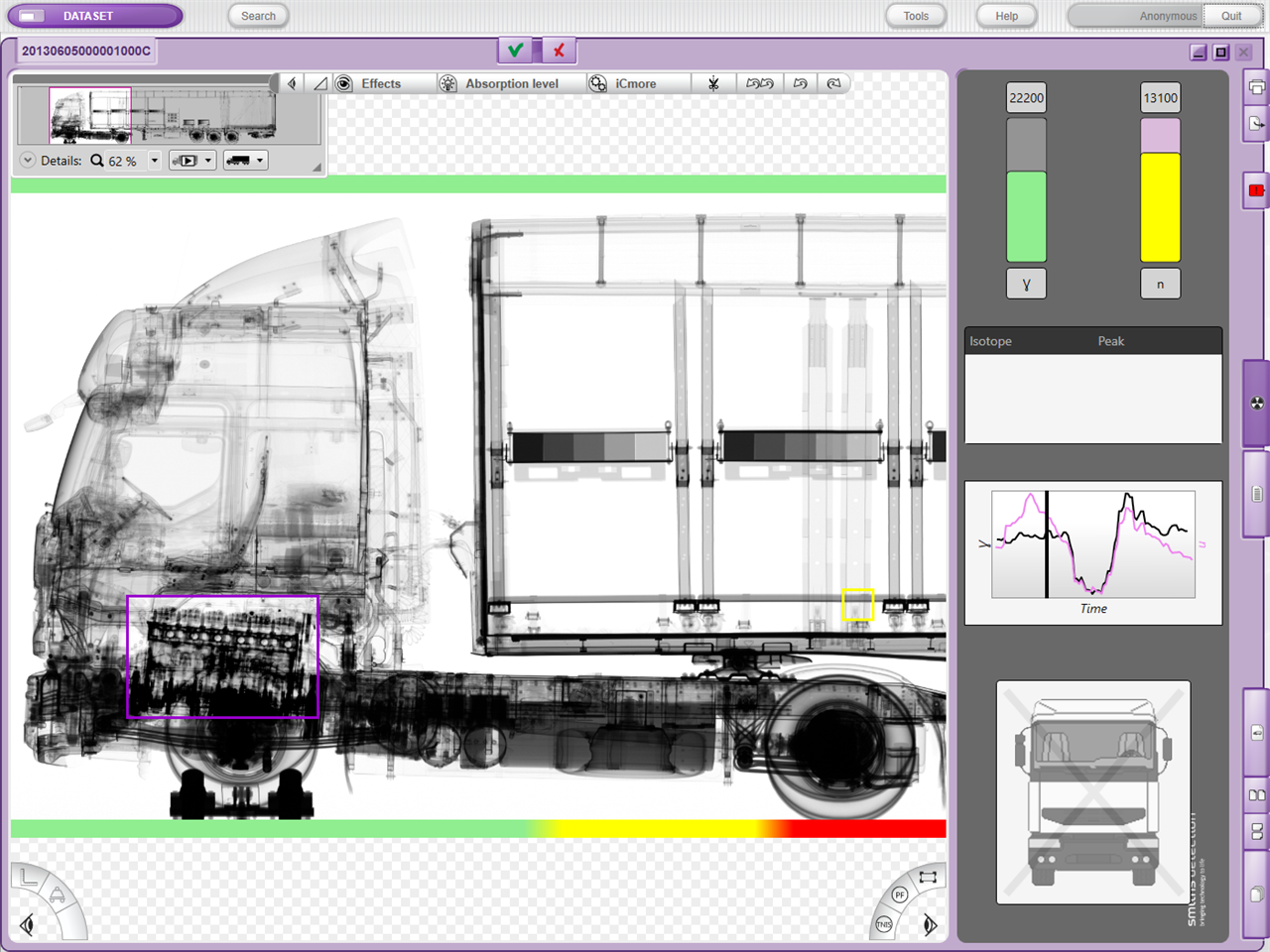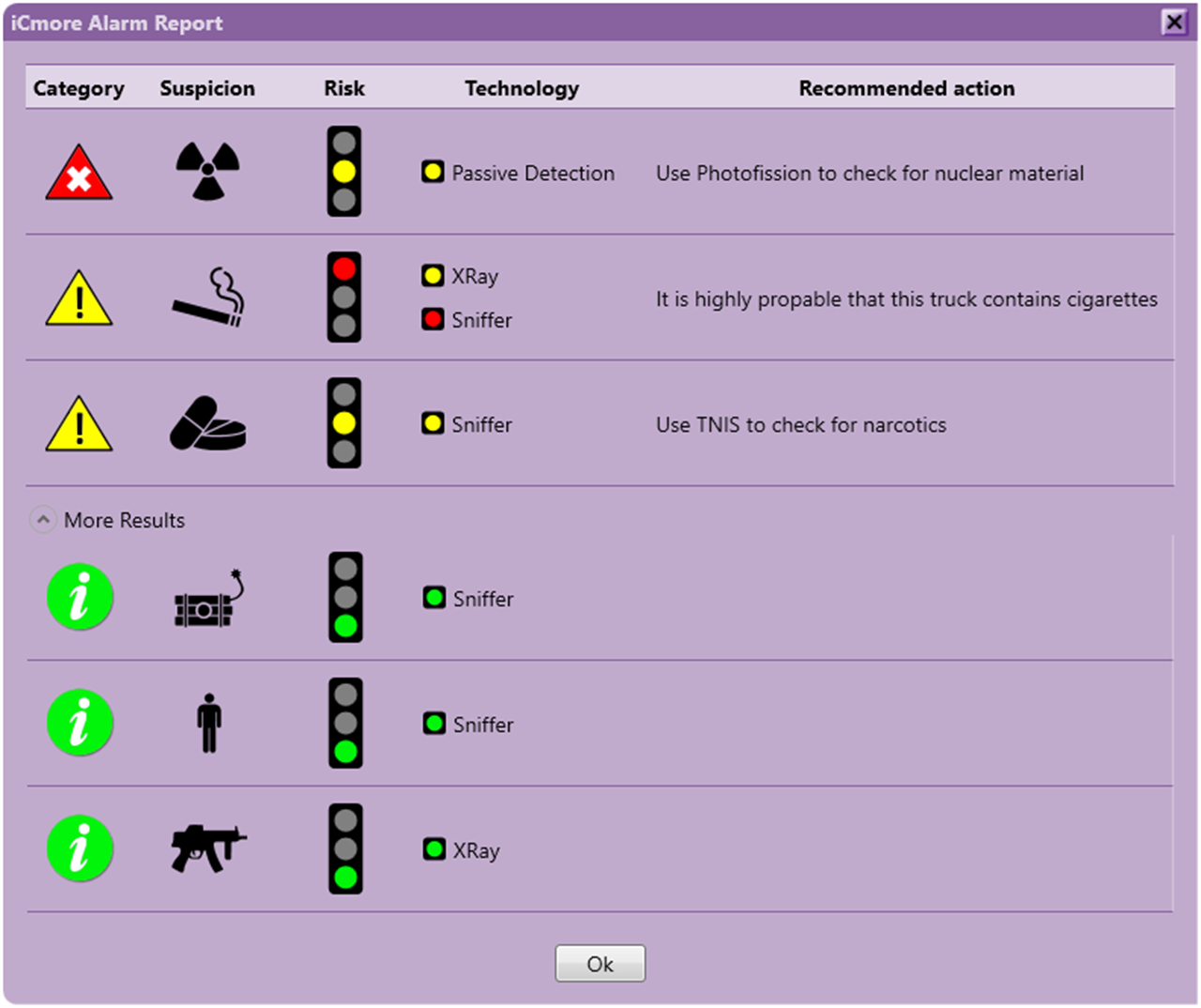Efficient non-intrusive inspection (NII) of containerised freight is increasingly critical to trade and society, as the criminal disruption of supply chains can severely harm the economy, as well as endanger public health and safety. The current methods for container NII combine intelligence-supported risk analysis and X-ray technology to combat illicit trafficking. However, this approach is limited due to health and safety regulations, long operator processing time to manually check containers in case of doubt and a lack of reliability due to insufficient ability to distinguish between innocent items and threats.

Screen captures from DaiSy, an analysis software tool from Smiths Detection. © Smiths Detection
Combining five NII technologies to ensure reliable inspections
Why inspect freight containers?
Freight containers can be used for smuggling, illegal immigration, trafficking of drugs and dangerous illicit substances, including nuclear material, chemical warfare agents and radioactively contaminated goods. But no single inspection technology available today can adequately cope with the challenge of reliably detecting all of these threats. This is where C-BORD comes in.
Within the framework of the C-BORD project, a new generation container inspection system is foreseen, combining advanced X-ray techniques capable of locating objects inside a large volume (cargo container) at a high rate, as well as additional techniques more sensitive to specific substances, such as advanced passive detection technologies, a tagged neutron inspection system, photo-fission technology and artificial sniffing. The data generated by the five technologies is collated in a single graphic user interface for customs decision-making.

Screen captures from DaiSy, an analysis software tool from Smiths Detection. © Smiths Detection
For passive detection, neutron and gamma detection sub-systems are designed to demonstrate the feasibility of using isotope identification to reduce false positive radiation alarms raised by naturally occurring radioactive materials, such as fertilizer.
The C-BORD Toolbox combines complementary innovative NII technologies
- Next generation cargo X-Ray
- Advanced radiation management
- Evaporation-based detection
- Tagged neutron inspection system
- Photo-fission
While previous “artificial sniffing” methods have failed because of the complexity of the problem at hand (notably in terms of sensitivity, environmental complexity, certification and practicality), a robust, highly sensitive evaporation-based detector is being developed to detect volatile chemicals that may be present in a container, giving warning of a hazard or contraband.
The development of the first “Rapidly Relocatable Tagged Neutron Inspection System” (RRTNIS) is also underway. The RRTNIS will be a second-line system to be used on sealed containers, enabling the detection of explosives, illicit drugs and chemical agents in a suspect voxel1.
1 A voxel (contraction of vox – volume – and el – element –) is a volume unit representing a value on a regular grid in three-dimensional space. The position of a voxel is inferred based upon its position relative to other voxels. Voxels are good at representing regularly sampled spaces that are non-homogeneously filled and are frequently used in the visualization and analysis of scientific data.
The photo-fission technique is intended to detect SNM (Special Nuclear Material – mainly uranium and plutonium isotopes), a crucial issue for homeland security applications. It allows for inspection of the cargo container without opening it, which is a time-consuming and potentially dangerous process. These detectors should complement X-ray imaging by enabling molecular-specific detection (providing chemical information instead of the object’s outline), thus improving the discrimination power of the scanning system.
The C-BORD project is also an opportunity to improve X-ray techniques, particularly with regard to the accuracy of material discrimination and image interpretation (Assisted / Automatic Target Recognition).
C-BORD aims to meet critical operational requirements and constraints, including:
- Increased throughput of containers per time unit
- Reduced need for costly, time-consuming and dangerous manual container inspections
- Lower false negative and false positive alarm ratios
From the lab to customs
Tailored and efficient solutions for end users
One of the benefits of the approach is that it proposes tailored solutions for very different customs / border-crossing situations, from mobile devices for a small land border-crossing to fixed installations for an automated system handling large volumes at a major port. Thus, the deployment of C-BORD solutions can address the problem of the weakest link in the control chain.If the aim of C-BORD is to develop new and improved NII technologies tailored to the customs’ working environment, they must be tried and tested in real operational conditions. This is why C-BORD is planning field trials in conjunction with customs’ partners. The performance of the technologies will be tested at three customs sites: Rotterdam, The Netherlands, testing equipment for a fully automated seaport; Gdańsk, Poland, implementing a rapidly relocatable checkpoint for ports; and Röszke, Hungary, deploying mobile equipment for a land border checkpoint. Thanks to the assessment of the enhanced technologies, and how their combined use allows for a reliable detection of radioactive material, explosives, chemicals, drugs and tobacco hidden in cargo containers, C-BORD will support the decision-making of end users, namely customs services, on how to combine and deploy technologies for different needs.
Last but not least, activities are governed by the standard research ethical principles relative to the safety and well-being of researchers, the public, private property and the environment. All trials are subject to authorisations from the appropriate national civilian health & safety authorities in charge of hazardous materials and active detection methods.
About the C-BORD project:
This project has received funding from the European Union’s Horizon 2020 research and innovation programme under grant agreement N° 653323. The C-BORD project, with a budget of 11.8M€, is coordinated by CEA, providing its expertise in the CBRNE and detection fields. 18 partners from nine countries are involved in the project.